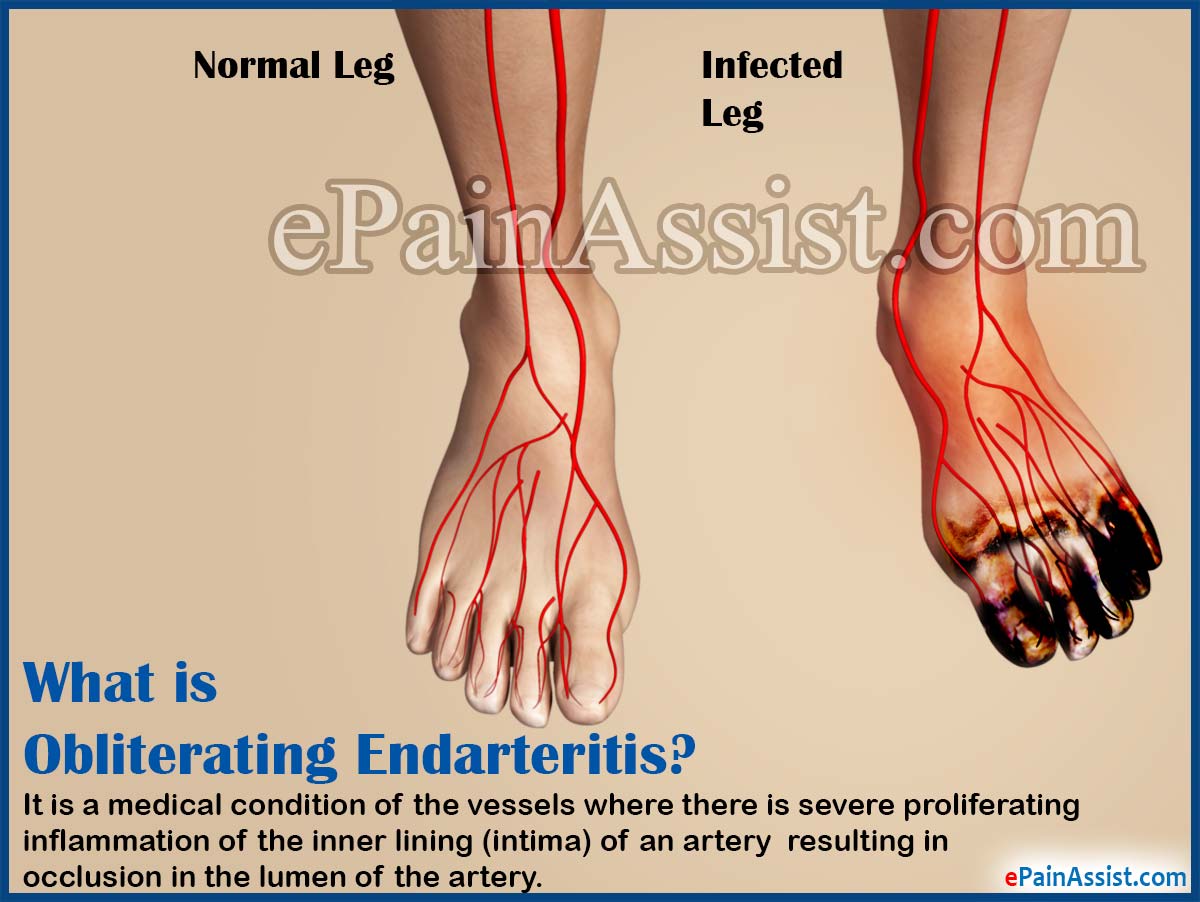What is Obliterating Endarteritis?
Obliterating endarteritis, which is also known as obliterating arteritis, is a medical condition of the vessels where there is severe proliferating inflammation of the inner lining (intima) of an artery resulting in occlusion in the lumen of the artery. This causes hindrance in the blood circulation and can also result in gangrene. There are different causes for obliterating endarteritis including medical conditions, such as tuberculosis, meningitis, syphilis and can also occur as a complication of radiation poisoning. In obliterating endarteritis, there are spasms occurring in the artery leading to obstruction in the arterial lumen. Women suffer more from Obliterating Endarteritis than men. Feet and lower legs are the most commonly affected regions.

Causes of Obliterating Endarteritis
- Chronic exposure and poisoning from certain substances, such as lead can cause arterial spasm leading to obliterating endarteritis.
- Persistent exposure to cold causes frostbite and leads to obliterating endarteritis.
- Chronic neuritis can also cause obliterating endarteritis.
- Any type of mechanical damage to the limbs also causes obliterating endarteritis.
- Smoking also causes constriction of the blood vessels leading to obliterating endarteritis.
- Infections, such as typhoid and syphilis can also result in obliterating endarteritis.
Symptoms of Obliterating Endarteritis
The symptoms of this condition develop gradually and include:
- In the initial stages of obliterating endarteritis, there is no organic change in the walls of the blood vessels with only periodic spasm in the vessels.
- Patient feels heaviness in the legs.
- There is dryness of the skin.
- Patient experiences symptoms of severe pain in the muscles, as this condition progresses.
- If treatment is not started, then there also may be development of ulcers and gangrene.

Treatment of Obliterating Endarteritis
Treatment, when sought early, not only helps in relieving this condition, but also helps in avoiding any surgical intervention. Depending on the severity of Obliterating Endarteritis, treatment comprises of conservative treatment and surgical treatment. There is no specific single treatment for this occlusive condition. Treatment for Obliterating Endarteritis depends on the patient and is an individualized and integrated approach with a combination of conservative and surgical modalities.
Conservative Treatment for Obliterating Endarteritis
- Conservative treatment of Obliterating Endarteritis comprises of making lifestyle changes, following a healthy diet, medications and physiotherapy.
- The lifestyle changes, which should be made, include quitting smoking, having regular meals, treating infections which are causing this condition etc.
- Conservative treatment for obliterating endarteritis firstly comprises of quitting smoking if the patient is a smoker. If the smoking is not stopped, then any type of treatment for obliterating endarteritis is ineffective. Other than this, medication and physical therapy are also used to treat Obliterating Endarteritis.
- The aim of conservative treatment is to prevent further obliteration of new parts of the arteries by using the following medications, such as vasodilators, medicines which reduce blood viscosity and clotting, improving the ischemic tissue, analgesics to relieve pain,
treating gangrenous regions and using antibiotics and sulfonamides to treat secondary infections. - The vessel spasm needs to be alleviated in order to increase the blood circulation and improve the function of the collateral vessels.
- Medications, which are commonly used in the treatment of endarteritis include vitamins B1, B2, B6, C, E and multivitamins, hormones such as testosterone, diethylstilbestrol, methyl testosterone, vasodilators such as depot-padutin and angiotrofin, anticoagulants such as bishydroxycoumarin and heparin etc.
- Intra-arterial injection comprising of novocain, caffeine, morphine and glucose is also used to treat Obliterating Endarteritis.
- Steroid hormones, such as prednisolone and hydrocortisone, are also effective in treating Obliterating Endarteritis.
Surgical Treatment for Obliterating Endarteritis
- Surgery is advised if the conservative measures do not work. Surgery is also required in severe cases of obliterating endarteritis.
- Surgery helps in reducing the tissue ischemia in patients who have not responded to conservative measures.
- Surgery for Obliterating Endarteritis is also done to improve the function of the collateral vessels.
- Surgical procedures comprise of sympathectomy of which the lumbar sympathectomy is the most effective. This surgery is most beneficial in the early stages of obliterating endarteritis. Other improvements which can be seen with surgery are alleviation of pain, reduced edema of the limbs, healing of ulcers and increase in the skin temperature.
- Surgery for Obliterating Endarteritis is also done to restore the patency of the large arteries, which is beneficial in cases where there is occlusion in a small region of a large vessel.
